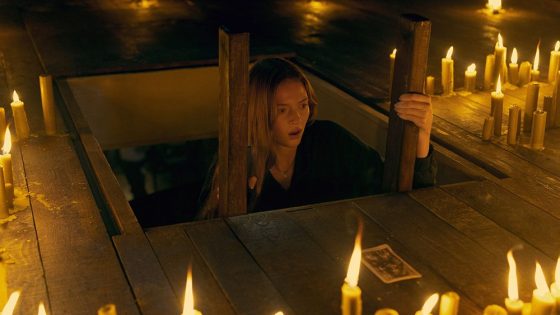Set in a world where every door creaks and there isn’t a single well-lit location, “Tarot” is little more than a clearinghouse of horror clichés.
Co-written, directed and executive produced by Spenser Cohen and Anna Halberg (the podcast series “Classified”), the supernatural thriller repeatedly leverages the genre’s laziest mood-setting and suspense-building devices to keep its audience on the edge of their seats. But even featuring a moderately charming ensemble led by “Spider-Man: Homecoming” breakout Jacob Batalon, the film’s PG-13 rating — and lack of virtually any characters other than its doomed protagonists — severely limits the efficacy of those techniques and tropes even when they’re deployed skillfully.
Batalon plays Paxton, the wisecracker among a studiously diverse college-age friend group that rents a remote mansion to celebrate the birthday of Elise (Larsen Thompson). Scouring their rental for booze, the group foolishly breaks into a room marked “KEEP OUT,” where instead of hooch they discover a dusty collection of occult trinkets — the centerpiece of which is a deck of hand-painted tarot cards in a wooden box. An amateur student of astrology, Haley (Harriet Slater) warns them off toying with somebody else’s cards, but Elise convinces her to do readings for each member of the group. The next day, one of their numbers dies under mysterious circumstances.
Grief-stricken, the remaining survivors gather to make sense of the loss, but when a second friend passes away, Haley, Paxton and the rest begin to suspect that the deaths aren’t pure coincidence. When they cross-reference the events that led their friends to their doom, Haley identifies that the tarot readings she gave directly delineated their fates — which tells her that the rest of them will also die in the near future. As they attempt to decode the cryptic sequences she described, ghostly figures begin to appear, threatening and chasing them into life-threatening situations. They eventually enlist the help of an occult expert, Ms. Astryn (Olwen Fouéré), who informs the quickly-shrinking group that they must find a way to break the curse that’s been placed on them before they all succumb to the cruel hand of fate.
Making their directorial debut with “Tarot,” Cohen and Halburg depart sharply from the plot of “Horrorscope,” the 1992 novel by Nicholas Adams upon which the film is supposedly based. Adams’ story was about a serial killer who chooses his victims by the signs of the zodiac. Their choice to pivot to a “Final Destination”/ “Ten Little Indians”-style story is neither good or bad on its face, but it isn’t more original than Adams’ premise, and anyway, any fans of the source material will likely identify little here that resembles it. Yet Cohen and Halburg create a scenario that requires the action to escalate very quickly, but don’t bother trying to create a real world in which these characters exist, much less where these events might unfold.
The explanation for the cursed deck, and for these teens to fall victim to it, makes basic (if cinematic) sense: an astrologer (Suncica Milanovic) exacts revenge for a personal betrayal over centuries, and the present-day kids are too young and dumb not to pay attention to an actual warning sign. But other than “the Catskills” as the site of the haunted mansion, where do these college students live? Not only are their supposed dorms completely empty of other people (roommates are spoken about but never seen, and background extras are nonexistent), but they’re all creaky, dark and run down.
The traditional visual language of horror movies has long since become boilerplate, but what the better of the genre’s filmmakers know, or hopefully learn, is that creating an uninterrupted dour and “scary” atmosphere exerts a flattening effect on the audience. Here, there’s no relief from the ambient menace of supernatural forces, and as a result, watching these characters walk yet again into a shadow-filled hallway becomes not increasingly suspenseful but tedious.
The other particularly overused tool in Cohen and Halburg’s arsenal is the extremely loud and sudden noise — about half of the most intense moments in the film pay off because the audience is startled, not frightened. Jump scares can be effective if they’re deployed sparingly, but here, they feel too often like a band-aid for lackluster storytelling or camera angles, the latter of which too frequently feature mysterious figures rushing around in the space between the characters and the camera.
It would be easy to blame the film’s teen-friendly rating for its underwhelming impact, especially when each character’s death feels neutered of viscera; even hit by a subway train or sawed into pieces, the blood and violence is always disembodied. But last year’s “The Boogeyman” was also PG-13, and even if it didn’t quite have the oomph of some of its more grown-up counterparts, it never made viewers feel like the film was wearing training wheels. Though “Tarot” is unquestionably more intense than, say, one of the “Goosebumps” movies, it at best feels like the kind of horror movie a scaredy-cat teenager might watch in order to gauge their readiness for more mature or graphic fare.
Despite the film’s stylistic limitations, a freshly scrubbed young adult cast sells more of its ideas than would otherwise work. Playing the film’s resident astrology aficionado, Slater is saddled with some truly howl-worthy dialogue, but she almost makes viewers believe that Haley is as haunted as her loss-filled back story suggests. And Adain Bradley, playing Haley’s recent ex-boyfriend Grant, makes a meal out of his character’s hunky, well-meaning obliviousness. Batalon, meanwhile, probably needs to find a role a bit further away from his “Spider-Man” sidekick Ned Leeds (maybe something non-comedic) than the motor-mouthed nerd, Paxton, but he exudes a similar charm as the film’s provider of comic relief.
Ultimately more a triumph of this-goes-to-11 sound mixing than storytelling, “Tarot” might offer a great time for a group of teenagers more interested in talking to one another in the theater than watching the movie, but anyone else — older or just genuinely eager to be thrilled — should beware. As the ongoing fire hose of genre films and TV shows has reiterated, horror has much to offer for a lot of different audiences, but this debut from Cohen and Halburg suggests that even if their target viewers are still in their adolescence, as filmmakers they also have much growing up to do.
Source Agencies


